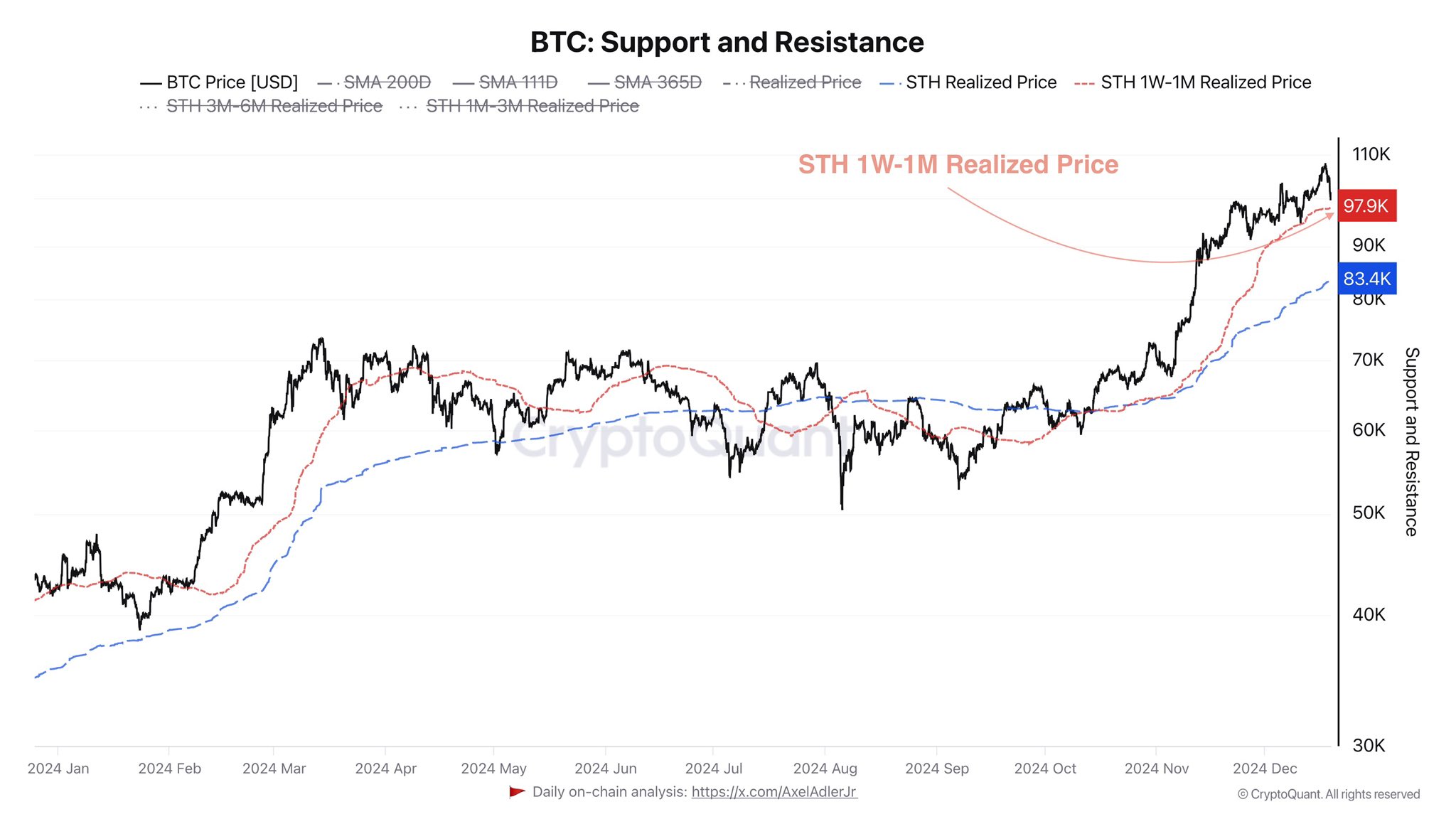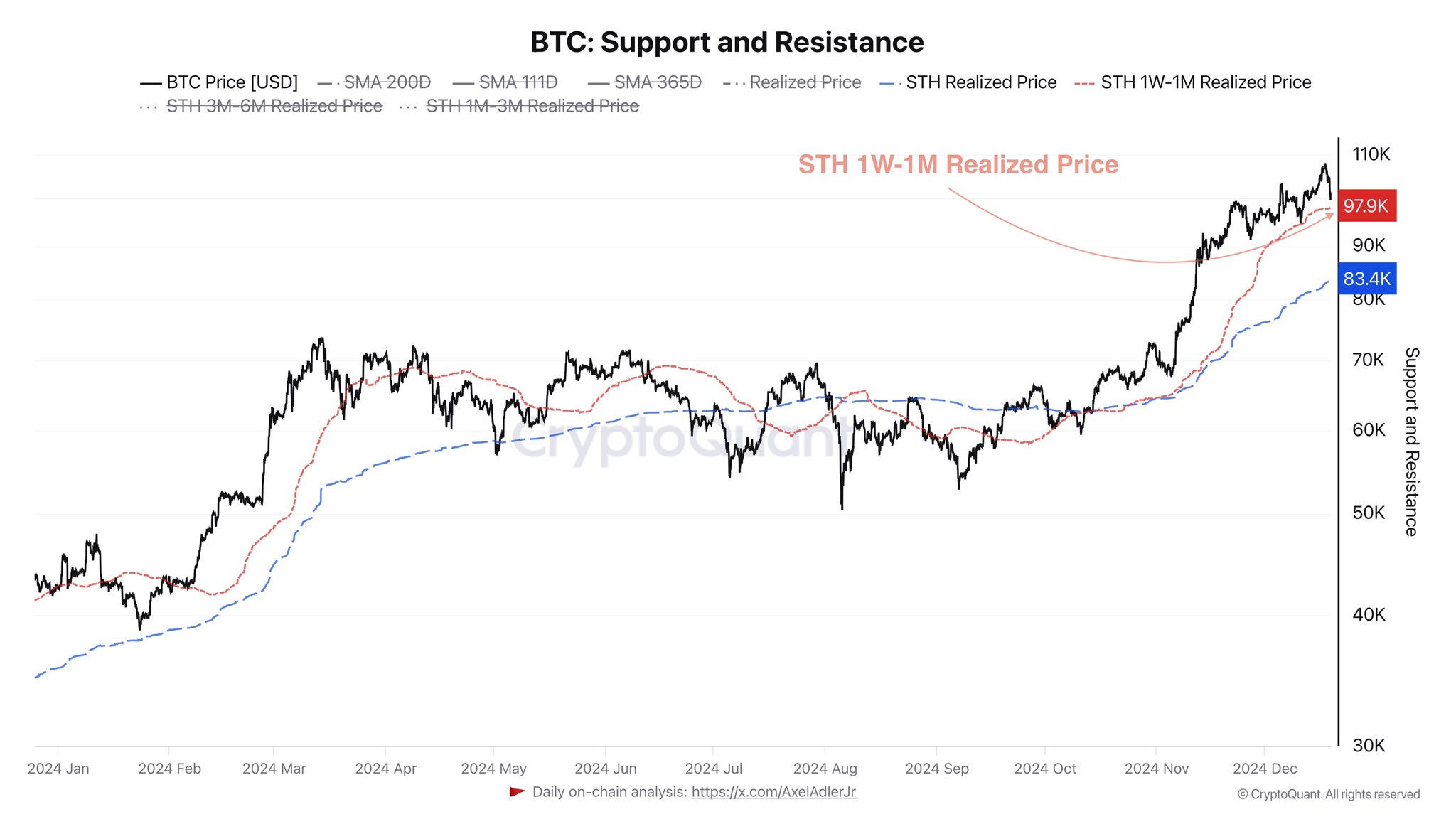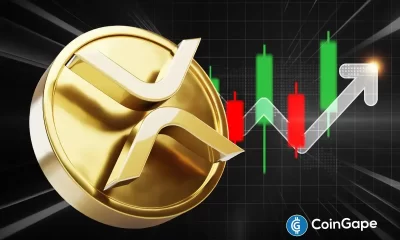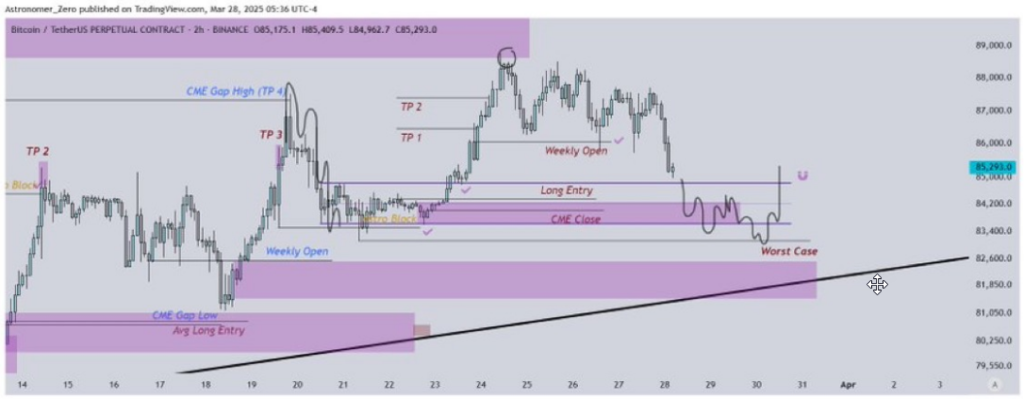Bitcoin
Here’s Where The Nearest On-Chain Support Is
Published
3 months agoon
By
admin
Bitcoin has observed a plunge during the past day. Here’s the nearest on-chain level that the asset would end up retesting if the drawdown elongates.
1 Week To 1 Month Bitcoin Holders Have Their Realized Price At $97,900
As pointed out by CryptoQuant author Axel Adler Jr in a new post on X, the Realized Price of the 1-week to 1-month-old BTC investors is the closest support for the asset right now.
Related Reading
The “Realized Price” here refers to an on-chain indicator that, in short, keeps track of the cost basis or acquisition price of the average holder on the Bitcoin network.
When the metric’s value is lower than the spot price of the cryptocurrency, it means the investors as a whole can be considered to be holding a net amount of profit. On the other hand, it being under the BTC value suggests the dominance of loss in the market.
In the context of the current topic, the Realized Price of only a particular segment of the sector is of interest: the 1-week to 1-month-old holders. This cohort includes the addresses that have been holding their coins for at least one week and, at most, one month.
Now, here is the chart shared by the analyst that shows how the Realized Price of this Bitcoin group has changed over the past year:

As displayed in the above graph, the Realized Price of the 1-week to 1-month-old Bitcoin investors has been climbing up alongside the price rally. This is naturally due to the fact that the cohort’s cost basis has been getting repriced to higher levels as new investors have been purchasing at the rally highs.
Currently, the indicator’s value sits at $97,900, so these investors would be in profit at the current price. Earlier in the past day, however, the asset came dangerously close to retesting the level as its price saw a brief dip below $99,000.
The 1 week to 1 month old investors make up a section of a larger cohort known as the short-term holders (STHs). The STHs are broadly defined as the holders who bought their coins within the past 155 days.
Statistically, the longer an investor holds onto their coins, the less likely they become to sell. So, the STHs, and especially the 1-week to 1-month-old segment, would contain the holders with the least amount of resolve in the sector, owing to their low holding time.
Because of how fickle they are, the STHs generally show some kind of reaction whenever their average cost basis gets retested by the Bitcoin price. This reaction may come in the form of buying when the retest occurs from above, as these holders could believe the decline to be just a ‘dip.’
As such, the Realized Price of the 1-week to 1-month-old STHs, which is below the current price, could be looked at as a support level for the cryptocurrency. The level has also already helped the asset out once this month.
Related Reading
So far, Bitcoin has been making a recovery from the plummet, but should the bearish momentum return, the retest of the line may be to watch for, considering the past pattern.
BTC Price
At the time of writing, Bitcoin is trading at around $102,200, down almost 3% in the last 24 hours.
Featured image from Dall-E, CryptoQuant.com, chart from TradingView.com
Source link
You may like


Bitcoin Miner MARA Starts Massive $2B At-the-Market Stock Sale Plan to Buy More BTC


Paul Atkins “Conflict of Interest” Triggers $220M Withdrawals from Ripple Markets


Bitcoin CME Gap Close About To Happen With Push Toward $83k


Listing an altcoin traps exchanges on ‘forever hamster wheel’ — River CEO


Nasdaq Files To Launch a New Grayscale Avalanche (AVAX) Exchange-Traded Fund


How To Measure The Success Of A Bitcoin Treasury Company
Bitcoin
Bitcoin Miner MARA Starts Massive $2B At-the-Market Stock Sale Plan to Buy More BTC
Published
22 minutes agoon
March 30, 2025By
admin

Bitcoin mining company MARA Holdings (MARA) is launching a fresh $2 billion stock offering to buy more bitcoin, continuing its plan of buying BTC in the open market through capital raise while sticking to its “Hodl” strategy.
According to a Form 8-K and a new prospectus filed with the U.S. Securities and Exchange Commission (SEC), MARA entered into an at-the-market (ATM) equity program with a group of investment banks including Barclays, BMO Capital Markets, BTIG, Cantor Fitzgerald, and others. The proceeds of the offering, which will see brokers selling shares of the miner from time to time, will be used mainly for the acquisition of bitcoin in the open market.
“We currently intend to use the net proceeds from this offering for general corporate purposes, including the acquisition of bitcoin and for working capital,” MARA said in its prospectus.
This new fresh stock sales plan follows a previous ATM offering that targeted up to $1.5 billion for the miner.
MARA has adopted Michael Saylor’s strategy of raising funds through equity and convertible bond offerings and buying bitcoin in the open market. The miner now holds 46,376 BTC in its treasury, making it the second-largest bitcoin stash among publicly traded companies, behind Strategy’s 506,137 BTC.
The plan to buy bitcoin in the open market was adopted by the miner last year, even though a miner can theoretically mine bitcoin at a discount to the spot price. The industry became challenging after last year’s halving cut mining rewards by half, squeezing profit margins on the back of rising costs. This made buying bitcoin in the open market, alongside mining, a relatively better strategy for the miners.
Read more: Bitcoin Mining Is So Rough a Miner Adopted Michael Saylor’s Successful BTC Strategy
Source link
Bitcoin
Bitcoin CME Gap Close About To Happen With Push Toward $83k
Published
2 hours agoon
March 30, 2025By
admin
Reason to trust

Strict editorial policy that focuses on accuracy, relevance, and impartiality
Created by industry experts and meticulously reviewed
The highest standards in reporting and publishing
Strict editorial policy that focuses on accuracy, relevance, and impartiality
Morbi pretium leo et nisl aliquam mollis. Quisque arcu lorem, ultricies quis pellentesque nec, ullamcorper eu odio.
Bitcoin (BTC) is steadily approaching the highly anticipated Chicago Mercantile Exchange (CME) gap close, with price action aligning with analyst’s expectations of a move toward $83,000. As Bitcoin corrects from recent highs, a crypto analyst expects a rebound to come next. However, if key support fails, the possibility of further downside remains.
Bitcoin To Drop To CME Gap Close
Bitcoin has been on a rollercoaster this year, skyrocketing to new ATHs and experiencing major price breakdowns that pushed it to new lows. Recently the cryptocurrency saw a surge toward $89,000 but faced a rejection. Now the top crypto is pulling back again, with crypto analyst Astronomer on X (formerly Twitter) pinpointing the $83,000 – $84,000 low range as its next critical support level.
Related Reading
This crucial support zone in the price chart aligns with the CME gap close, a common phenomenon in the BTC Futures market. BTC revisits price gaps left when the CME price closes over the weekend and opens on Sundays.

Astronomer has outlined his long-term trading plan for Bitcoin, expecting the cryptocurrency to consolidate around the support level before bouncing. He believes that the CME gap close is a significant technical development that could determine Bitcoin’s price movements.
Supporting the expectations of a short-term pullback, historically, a bearish close on Friday often leads to red Mondays or Tuesdays for Bitcoin. Moreover, the analyst highlights that the market is still in the pre-New York Open (NYO) phase, leaving room for an intraday reversal.
However, he anticipates a late-night drop during the NYO trading session due to the lack of liquidations and untested support levels. He also mentions that combined with these factors, Bitcoin’s recent pullback from $89,000 is a strong indication that its price may not be bullish locally.
Based on his Bitcoin price chart, Astronomer considers the $81,400 – $82,400 range the worst-case support zone. Bitcoin is expected to revisit this target zone before any attempt at a potential reversal.
Can Bitcoin Rebound? Take Profit Levels To Watch
While Bitcoin’s short-term price action appears bearish, its macro trend remains somewhat stable, according to Astronomer’s analysis. The analyst has marked a “long entry” zone in the chart, suggesting that the $83,000 – $84,000 zone was a potential buying opportunity if Bitcoin finds support there.
Related Reading
The analyst predicts that if Bitcoin can successfully hold the CME gap close, a bounce toward the weekly open price at $86,000 could be its first step toward a much-anticipated recovery. Beyond this, the analyst has pinpointed key take profit levels marked from TP1 – TP4 on the price chart. These levels suggest that Bitcoin could surge higher to reach a target of $87,000 – $88,000.
However, a break below the worst-case support zone could trigger a bearish shift in sentiment, potentially leading to a deeper price correction for Bitcoin.
Featured image from Gemini Imagen, chart from TradingView
Source link
Bitcoin
How To Measure The Success Of A Bitcoin Treasury Company
Published
4 hours agoon
March 30, 2025By
admin
In the world of traditional finance, evaluating a company’s success usually means tracking revenue growth, earnings per share, or return on equity. But what happens when the core of a company’s strategy isn’t selling products or services, but accumulating Bitcoin?
That’s the question facing a new class of Bitcoin treasury companies. These are publicly traded firms whose central mission is to acquire and hold Bitcoin over the long term. And to understand whether they’re succeeding, we need a fresh set of tools.
This article introduces those tools—new key performance indicators (KPIs) designed to evaluate how well a company is executing its Bitcoin strategy. Many of these indicators have been pioneered by Michael Saylor and his company, Strategy, where they can be seen implemented on their new dashboard. These new metrics may sound complex at first, but once broken down, they offer powerful insight into whether a Bitcoin treasury company is truly delivering for its shareholders.
1. BTC Yield: Measuring Accretion, Not Earnings
What it is: BTC Yield tracks the percentage change over time in the ratio between a company’s Bitcoin holdings and its fully diluted share count. In simple terms: how much more Bitcoin is owned per potential share of stock.
Why it matters: This KPI is designed to answer a unique question: Is the company acquiring Bitcoin in a way that benefits shareholders?
Let’s say a company holds 10,000 BTC and has 100 million diluted shares. That’s 0.1 BTC per share. If, a year later, it holds 12,000 BTC and has 105 million shares, it now holds ~0.114 BTC per share—a 14% increase. That 14% is your BTC Yield.
What makes it unique: BTC Yield doesn’t care about profit margins or EBITDA. It’s focused on how effectively the company is increasing Bitcoin ownership relative to the number of shares that could exist. This is key in a strategy that involves using equity to buy BTC. If management is printing new shares to buy Bitcoin, shareholders want to know: is the Bitcoin per share going up or down?
How to use it: Investors can track BTC Yield over time to see if dilution (more shares) is being offset by accretive Bitcoin purchases (more BTC). A consistently rising BTC Yield suggests management is executing well.
2. BTC Gain: The Bitcoin-Based Growth Metric
What it is: BTC Gain takes the BTC Yield and applies it to the company’s starting Bitcoin balance for a period. It tells you how many theoretical “extra” bitcoins the company effectively added through accretive behavior.
Why it matters: This is a way of visualizing BTC Yield not as a percentage, but as Bitcoin itself. If BTC Yield for the quarter is 5% and the company started with 10,000 BTC, BTC Gain is 500 BTC.
What makes it unique: It helps you think in Bitcoin terms, which aligns with the company’s long-term goal. Shareholders aren’t just watching for more BTC—they want more BTC per share. BTC Gain helps quantify how much more BTC the company would’ve had if it started from scratch and grew holdings accretively.
How to use it: BTC Gain is especially helpful when comparing different time periods. If one quarter shows 200 BTC Gain and the next shows 800 BTC Gain, you know the company’s Bitcoin strategy had a much stronger impact in the second period—even if the BTC price stayed flat.
3. BTC $ Gain: Bringing Bitcoin Gains Into Dollar Terms
What it is: BTC $ Gain translates BTC Gain into U.S. dollars by multiplying it by the price of Bitcoin at the end of the period.
Why it matters: Investors still live in a world dominated by fiat. Converting Bitcoin-based growth into dollar terms helps bridge the communication gap between Bitcoin-native strategy and traditional shareholder expectations.
What makes it unique: This metric offers a hybrid lens—Bitcoin-denominated growth, viewed in fiat terms. But here’s the catch: BTC $ Gain can show a positive number even if the actual value of the company’s holdings dropped (because the metric is based on share-adjusted accumulation, not fair market value accounting).
How to use it: Use this metric to contextualize how much value (in dollars) the company’s Bitcoin acquisition strategy may have created over a period—just remember that it’s not a profit measure. It’s a reflection of growth in stake, not accounting gain or loss.
4. Bitcoin NAV: A Snapshot of Raw Bitcoin Holdings
What it is: Bitcoin NAV (Net Asset Value) is the market value of the company’s Bitcoin holdings. It’s calculated simply: Bitcoin Price × Bitcoin Count.
Why it matters: It gives a snapshot of the company’s Bitcoin “war chest,” plain and simple.
What makes it unique: Unlike traditional NAV used in mutual funds or ETFs, this version ignores liabilities like debt or preferred stock. It’s not meant to tell you what shareholders would get in a liquidation. Instead, it’s just: How much Bitcoin does the company own, and what is it worth right now?
How to use it: Use Bitcoin NAV to understand the scale of the company’s Bitcoin strategy. A rising NAV could reflect more Bitcoin, higher prices, or both. But remember: it’s not adjusted for debt or financial obligations, so it’s not a full picture of shareholder value.
5. BTC Rating: The Leverage Check You Don’t Have to Guess About
What it is: BTC Rating is a simple ratio: the market value of the company’s Bitcoin divided by its total financial obligations. It shows how much of the company’s debt and liabilities could be covered by its Bitcoin holdings.
Why it matters: This metric gives a Bitcoin-native snapshot of balance sheet strength. It helps investors quickly gauge whether a company’s Bitcoin strategy is supported by a sound capital structure—or weighed down by obligations.
What makes it unique: Unlike traditional credit ratings that rely on opaque models and institutional trust, BTC Rating is transparent and verifiable. The inputs—Bitcoin holdings and liabilities—are public. It puts solvency into plain sight, without needing anyone’s permission or opinion.
How to use it: A BTC Rating above 1.0 suggests the company’s Bitcoin position outweighs its obligations—a strong indicator of strategic flexibility and solvency. A rating below 1.0 may signal over-leverage or exposure to refinancing risk. Watching how this ratio evolves over time gives investors a powerful lens for evaluating whether the company’s Bitcoin-first strategy is being executed responsibly.
Why These Metrics Matter Together
Each KPI gives a different lens:
- BTC Yield shows shareholder-accretive growth.
- BTC Gain translates that into BTC terms.
- BTC $ Gain puts it in dollars.
- Bitcoin NAV shows raw Bitcoin value.
- BTC Rating tests how that value stacks up against liabilities.
Used together, they give investors a comprehensive picture of whether a Bitcoin treasury company is:
- Growing its stake effectively
- Protecting or enhancing shareholder value
- Managing risk appropriately
One Final Note: These Metrics Aren’t Perfect
These KPIs are not traditional financial metrics, and they aren’t meant to be. They ignore things like operating revenue, cash flow, or even debt service costs. They also assume that convertible debt will convert, not mature.
In other words, they’re tools designed to isolate the Bitcoin strategy, not the whole business. That’s why they should be used alongside a company’s financial statements—not as a substitute.
But for investors trying to understand whether a company is making smart moves in the Bitcoin arena, these metrics offer something traditional tools can’t: clarity on whether management is using equity and capital in a way that actually grows Bitcoin per share.
And in a Bitcoin-first world, that just might be the most important metric of all.
Disclaimer: This content was written on behalf of Bitcoin For Corporations. This article is intended solely for informational purposes and should not be interpreted as an invitation or solicitation to acquire, purchase, or subscribe for securities.
Source link

Bitcoin Miner MARA Starts Massive $2B At-the-Market Stock Sale Plan to Buy More BTC

Paul Atkins “Conflict of Interest” Triggers $220M Withdrawals from Ripple Markets

Bitcoin CME Gap Close About To Happen With Push Toward $83k

Listing an altcoin traps exchanges on ‘forever hamster wheel’ — River CEO

Nasdaq Files To Launch a New Grayscale Avalanche (AVAX) Exchange-Traded Fund

How To Measure The Success Of A Bitcoin Treasury Company

Why ‘Tiger King’ Joe Exotic Launched a Solana Meme Coin From Behind Bars

Trump pardons BitMEX, is ‘Bitcoin Jesus’ Roger Ver next?

Terraform Labs to Open Claims Portal for Investors on March 31

BitGo CEO Calls For Regulation Amid Galaxy Digital’s Settlement

Ethereum Bulls Disappointed As Recovery Attempt Fails At $2,160 Resistance

US recession 40% likely in 2025, what it means for crypto — Analyst

Crypto Investment Firm Galaxy Digital Settles With New York AG for $200,000,000 Over Luna Allegations

Bitcoin Covenants: CHECKTEMPLATEVERIFY (BIP 119)

This Week in Bitcoin: GameStop Reveals Reserve, But Inflation Fears Rear Their Head

Arthur Hayes, Murad’s Prediction For Meme Coins, AI & DeFi Coins For 2025

Expert Sees Bitcoin Dipping To $50K While Bullish Signs Persist

Aptos Leverages Chainlink To Enhance Scalability and Data Access

Bitcoin Could Rally to $80,000 on the Eve of US Elections

Sonic Now ‘Golden Standard’ of Layer-2s After Scaling Transactions to 16,000+ per Second, Says Andre Cronje

Institutional Investors Go All In on Crypto as 57% Plan to Boost Allocations as Bull Run Heats Up, Sygnum Survey Reveals

Crypto’s Big Trump Gamble Is Risky

Ripple-SEC Case Ends, But These 3 Rivals Could Jump 500x

Has The Bitcoin Price Already Peaked?

A16z-backed Espresso announces mainnet launch of core product

Xmas Altcoin Rally Insights by BNM Agent I

Blockchain groups challenge new broker reporting rule

The Future of Bitcoin: Scaling, Institutional Adoption, and Strategic Reserves with Rich Rines

Trump’s Coin Is About As Revolutionary As OneCoin

Is $200,000 a Realistic Bitcoin Price Target for This Cycle?
Trending

 24/7 Cryptocurrency News5 months ago
24/7 Cryptocurrency News5 months agoArthur Hayes, Murad’s Prediction For Meme Coins, AI & DeFi Coins For 2025

 Bitcoin2 months ago
Bitcoin2 months agoExpert Sees Bitcoin Dipping To $50K While Bullish Signs Persist

 24/7 Cryptocurrency News3 months ago
24/7 Cryptocurrency News3 months agoAptos Leverages Chainlink To Enhance Scalability and Data Access

 Bitcoin5 months ago
Bitcoin5 months agoBitcoin Could Rally to $80,000 on the Eve of US Elections

 Altcoins2 months ago
Altcoins2 months agoSonic Now ‘Golden Standard’ of Layer-2s After Scaling Transactions to 16,000+ per Second, Says Andre Cronje

 Bitcoin5 months ago
Bitcoin5 months agoInstitutional Investors Go All In on Crypto as 57% Plan to Boost Allocations as Bull Run Heats Up, Sygnum Survey Reveals

 Opinion5 months ago
Opinion5 months agoCrypto’s Big Trump Gamble Is Risky

 Price analysis5 months ago
Price analysis5 months agoRipple-SEC Case Ends, But These 3 Rivals Could Jump 500x


